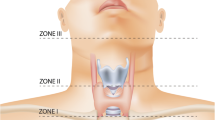Abstract
Background
Neck computed tomography (CT) angiography is commonly ordered for pediatric patients with soft palate trauma to exclude vascular injury. Debate exists regarding what type of imaging is indicated in this setting, particularly amid growing concern that standard neck CT angiography results in considerable radiation exposure.
Objective
To assess the diagnostic yield and estimated dose reduction of a novel targeted protocol extending from the skull base to the hyoid bone to evaluate pediatric oropharyngeal trauma.
Materials and methods
A retrospective imaging and medical chart review was performed of patients for whom a neck CT angiography was obtained for an indication of oropharyngeal trauma between 2008 and 2018. Effective dose and size-specific dose estimates (SSDEs) were estimated for standard and targeted neck CT angiography protocols with calculation of percent dose reduction of the targeted exams.
Results
Ninety-eight CT angiography examinations were reviewed. No cases were positive for neurological or major vessel injury; one case was positive for small vessel extravasation. Clinically significant nonvascular findings included phlegmonous change, retained foreign body, retropharyngeal/mediastinal air and pterygoid process fracture. With the exception of mediastinal air, all findings would have been included in the targeted protocol. Effective dose and SSDE were calculated for all cases where CTDIvol (volume CT dose index) had been reported (n=72). There was a statistically significant reduction in dose for the targeted protocol with an effective dose decrease of 69.7%±10.5% (P=0.009) and SSDE decrease of 53.9%±14.7% (P=0.01). Limiting ionizing radiation to the lung apices, esophagus and thyroid gland provided the greatest dose savings.
Conclusion
Based on low diagnostic yield and high radiation dose associated with standard neck CT angiography for evaluating oropharyngeal trauma, a targeted protocol is recommended, resulting in significantly less dose to the neck, while preserving diagnostic yield.







Similar content being viewed by others
References
Smith A, Ray M, Chaiet S (2018) Primary palate trauma in patients presenting to US emergency departments, 2006-2010. JAMA Otolaryngol Head Neck Surg 144:244–251
Hennelly K, Kimia A, Lee L et al (2010) Incidence of morbidity from penetrating palate trauma. Pediatrics 126:e1578–e1584
Soose RJ, Simons JP, Mandell DL (2006) Evaluation and management of pediatric oropharyngeal trauma. Arch Otolaryngol Head Neck Surg 132:446–451
Hengerer AS, DeGroot TR, Rivers RJ Jr, Pettee DS (1984) Internal carotid artery thrombosis following soft palate injuries: a case report and review of 16 cases. Laryngoscope 94:1571–1575
Hennus MP, Speleman L (2011) Internal maxillary artery pseudoaneurysm: a near fatal complication of seemingly innocuous pharyngeal trauma. Case Rep Crit Care 2011:241375
Brietzke SE, Jones DT (2005) Pediatric oropharyngeal trauma: what is the role of CT scan? Int J Pediatr Otorhinolaryngol 69:669–679
Hennelly KE, Fine AM, Jones DT, Porter S (2013) Risks of radiation versus risks from injury: a clinical decision analysis for the management of penetrating palatal trauma in children. Laryngoscope 123:1279–1284
Christner JA, Kofler JM, McCollough CH (2010) Estimating effective dose for CT using dose-length product compared with using organ doses: consequences of adopting International Commission on Radiological Protection publication 103 or dual-energy scanning. AJR Am J Roentgenol 194:881–889
Oppenheimer AG, Fulmer S, Shifteh K et al (2010) Cervical vascular and upper airway asymmetry in Velo-cardio-facial syndrome: correlation of nasopharyngoscopy with MRA. Int J Pediatr Otorhinolaryngol 74:619–625
Boone JM, Strauss KJ, Hernandez AM et al (2019) Size-specific dose estimate (SSDE) for head CT: The Report of the AAPM Task Group 293. https://www.aapm.org/pubs/reports/RPT_293.pdf. Accessed 9 Dec 2019
McCollough C, Bakalyar DM, Bostani M et al (2014) Use of water equivalent diameter for calculating patient size and size-specific dose estimates (SSDE) in CT: the report of AAPM task group 220. AAPM Rep 2014:6–23
Paquet F, Etherington G, Bailey MR et al (2015) ICRP publication 130: occupational intakes of radionuclides: part 1. Ann ICRP 44:5–188
Raol N, Caruso P, Hartnick CJ (2015) Use of imaging to evaluate course of the carotid artery in surgery for velopharyngeal insufficiency. Ann Otol Rhinol Laryngol 124:261–265
Randall DA, Kang DR (2006) Current management of penetrating injuries of the soft palate. Otolaryngol Head Neck Surg 135:356–360
Roberson D (2020) Oropharyngeal trauma in children. In: Bachur RG (ed). UpToDate, Waltham, MA. https://www.uptodate.com/contents/oropharyngeal-trauma-in-children. Accessed 9 Dec 2019
Hoang JK, Branstetter BF 4th, Eastwood JD, Glastonbury CM (2011) Multiplanar CT and MRI of collections in the retropharyngeal space: is it an abscess? AJR Am J Roentgenol 196:W426–W432
Author information
Authors and Affiliations
Corresponding author
Ethics declarations
Conflicts of interest
None
Additional information
Publisher’s note
Springer Nature remains neutral with regard to jurisdictional claims in published maps and institutional affiliations.
Rights and permissions
About this article
Cite this article
Choi, J.J., Burton, C.S., Danehy, A.R. et al. Neck CT angiography examinations for pediatric oropharyngeal trauma: diagnostic yield and proposal of a new targeted technique. Pediatr Radiol 50, 1602–1609 (2020). https://doi.org/10.1007/s00247-020-04737-7
Received:
Revised:
Accepted:
Published:
Issue Date:
DOI: https://doi.org/10.1007/s00247-020-04737-7




